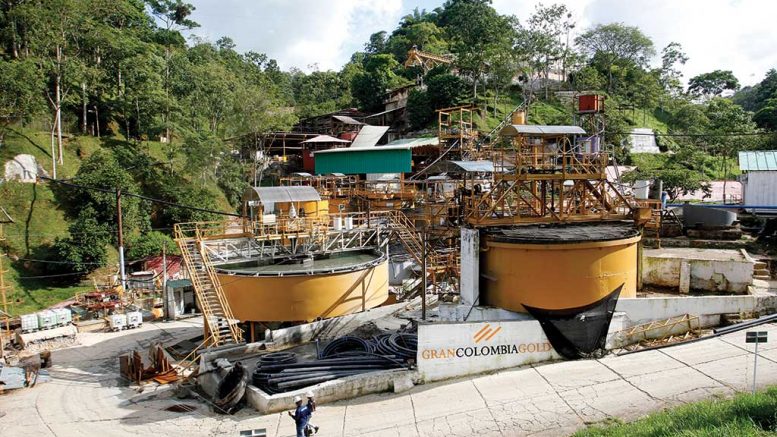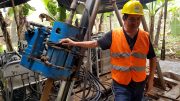With several underground mines and two processing plants at its Segovia and Marmato operations in Colombia, Gran Colombia Gold (TSX: GCM; US-OTC: TPRFF) is the South American country’s largest underground gold and silver producer.
Gran Colombia Gold’s mining operations also incorporate an artisanal miner model that contracts third-party miners to work on its concessions and deliver mineralized material to the company’s mill for processing — enhancing its relations with the local community.
“Rather than displace the artisanal miners, we allowed them to stay where they are working — as long as they are not interfering with our operation,” explains Mike Davies, the company’s chief financial officer. “We entered into contracts with them. We buy their material for our processing plant and pay them based on the gold content, and then take it from there.”
Davies notes that Segovia — which the company acquired in 2010 — is in a historic mining district, and artisanal miners have mined there for generations. “People just want to mine like their parents, grandparents and great grandparents,” he says. “It’s part of our social licence to operate.”
He also notes that the company’s contracts help artisanal miners pursue their livelihoods — despite the fact that they do not have legal title to the land, and could not otherwise sell their ore to a processing plant.
Government regulations to formalize the artisanal mining sector and restrict the use of mercury and explosives have made it harder for artisanal miners, Davies says. “The new laws focus on small miners — if they want to sell material to a processing plant, they have to have a certificate of origin to show that they have legal title to the material.”
Gran Colombia Gold has over 30 contracts with artisanal miners at its Segovia concessions and follows a similar model at Marmato, where it has four contracts, and is negotiating another three. Altogether, Davies says, the gold produced from mineralized material provided by artisanal miners makes up between 8% and 10% of the company’s total production.
“It’s a way to cohabitate,” Davies says. “We offer a solution as to where they can sell their material that is legal and environmentally responsible. It’s an important aspect of our business, in terms of partnering with the community.”
Last year the company produced 218,001 oz. gold — a 25% increase over 2017. This year it expects to produce between 210,000 and 225,000 oz. gold.

Workers underground at Gran Colombia Gold’s Segovia gold mine in Colombia. Credit: Gran Colombia Gold.
Its Segovia operations — which consist of the producing El Silencio, Providencia and Sandra K mines — make up most of the company’s total gold production (193,050 oz. in 2018).
The three underground mines — which have operated continuously for over 150 years — are situated within a couple kilometres of one another on the company’s 30 sq. km title, 180 km northeast of Medellin. Segovia also contains the Carla underground mine, 10 km southeast.
Segovia has measured and indicated resources of 3.5 million tonnes grading 11.8 grams gold per tonne for 1.3 million contained oz. gold, and inferred resources of 3.6 million tonnes grading 10.1 grams gold per tonne for 1.2 million oz. gold.
El Silencio — the oldest and deepest of the three mines — reaches 1 km deep. Of Gran Colombia Gold’s 424 channel samples from this depth, 69% averaged 10 grams gold or more, and 39% averaged over 30 grams gold. “That’s pretty good,” Davies says. “Thirty grams gold per tonne is almost 1 oz. gold, so that’s a pretty exciting area.”
The two other mines — La Providencia and Sandra K — extend to 600 and 400 metres’ depth.
This year Gran Colombia Gold plans to drill 10,000 metres at El Silencio to extend the north, middle and south ore shoots 200 metres down-plunge, below the delineated mineral resource. It also plans to drill 4,000 metres each at La Providencia and Sandra K, and has earmarked funds to drill 2,000 metres on one of the 24 veins on the property called “Cogote.”
The company has four diamond drill rigs turning at Segovia, with three rigs carrying out resource definition within the underground developments at Providencia, Sandra K and El Silencio, and one rig operating from surface at Campo Alegre targeting the down-plunge extension of the north ore shoot at El Silencio.
The 20,000-metre drill program at Segovia can be funded from cash flow, but the company plans to increase the drill program with another 60,000 metres over the next two years. To that end, it announced a $20-million convertible debenture bought deal on March 4 to fund the exploration program. “The 60,000 metres will start mid-year and carry through to the end of 2020,” Davies says. “We’re doing five years of drilling in the next two years by raising that money.
“Our reserves at Segovia are good for three or four years, so our objective by accelerating the drilling is to accelerate the conversion of resources to reserves, and have a much stronger mine life in front of us.”
At the end of February, the company released assay results from 83 drill holes (8,043 metres) drilled in 2018.
Highlights from infill drilling at Providencia included 84.10 grams gold and 97.7 grams silver over 0.7 metre and 105.93 grams gold and 65.2 grams silver over 0.4 metre in the Providencia vein. The drill program delineated a new high-grade zone west and near the high-grade orebody in production, with maximum grades of 15.49 grams gold and 22.7 grams silver over 3 metres.
Infill drilling at Sandra K continued to delineate and extend down-plunge the main ore shoots outlined by mining within the upper levels of the existing operation. Assays from 35 holes drilled from underground on the main vein system returned 84.14 grams gold and 94.1 grams silver over 2 metres, and 44.46 grams gold and 141.5 grams silver over 2 metres.
At El Silencio, infill drilling returned grades of 14.09 grams gold and 37.9 grams silver over 2 metres on the Manto vein, and 15.78 grams gold and 14.2 grams silver over 1 metre on the 1385 vein.
Meanwhile, Gran Colombia Gold continues to advance its Marmato project, which it acquired through its 2011 merger with Medoro Resources.
Marmato is 80 km south of Medellin in the heart of the country’s Middle Cauca gold district. It is located close to the Pan American Highway and has access to the national electricity grid, which runs near the property.
Medoro consolidated the various areas of the Marmato mountain in 2009 and 2010 — including the Zona Alta exploration project, the Marmato underground mine in Zona Baja (which produces 25,000 oz. gold a year), and the Echandia exploration project to the north.
When the gold price collapsed in 2013, Gran Colombia put Marmato on hold and focused on its Segovia operations, because they were producing cash.
Then, in 2017, when the Segovia operations were running smoothly and the gold price was higher, Gran Colombia looked at Marmato again and changed the focus of the project from an open pit to an underground operation.
“Originally it was thought of as a very large, low-grade open pit,” Davies says. “It had over 14 million oz. gold identified in the resource, but the development of that project came with very high front-end capital costs, and with some social issues, because there is a town at the top of the mountain.”
Drilling before 2017 had shown higher-grade, porphyry-style mineralization below the underground mine, so the company decided to follow up. It completed 8,200 metres in 2018 to help establish confidence in the opportunity at depth.
Now the company is working on a preliminary economic assessment study of Marmato predicated on an expansion of the existing underground mine at depth. That model, Davies says, “will probably have a lower upfront capital cost that could be financed in today’s market, and it would not have any of the social issues accompanied with an open pit.”
“We’re moving the studies forward, and later this year, we will have a better idea of size and scale, and how we’re going to move forward.”
The top of the mountain sits 1,500 metres above sea level, and Marmato is being mined at 1,000 metres above sea level. The deeper underground mine Gran Colombia Gold is contemplating would be in a zone between 500 metres and 1,000 metres above sea level.
Marmato has 41.2 million measured and indicated tonnes grading 2.9 grams gold and 17 grams silver per tonne for 3.89 million contained oz. gold and 22.56 million oz. silver. In addition, it has inferred resources of 52 million tonnes grading 2.5 grams gold and 9 grams silver for 4.19 million contained oz. gold and 15 million contained oz. silver.
In January, Gran Colombia Gold adopted a shareholder rights plan agreement. At the time it reported that to its knowledge, no existing shareholder owned more than 20% of the company.
The company has 48-million shares outstanding for a $167-million market capitalization.
At press time, Gran Colombia Gold was trading at $3.47 per share within a 52-week range of $2.02 to $4.67.





Be the first to comment on "Gran Colombia Gold works with artisanal miners"